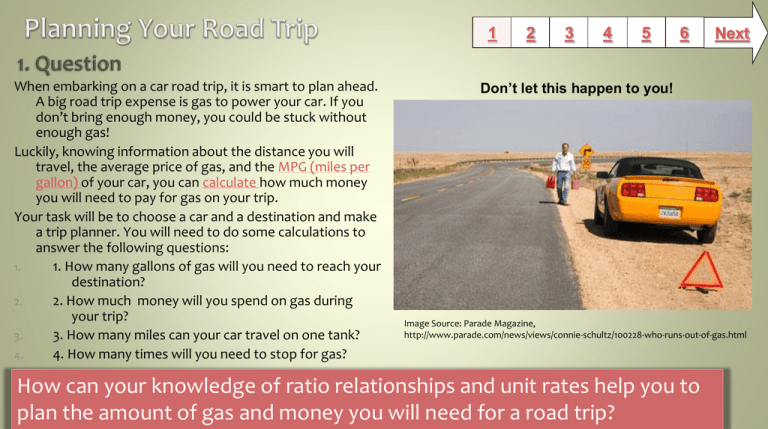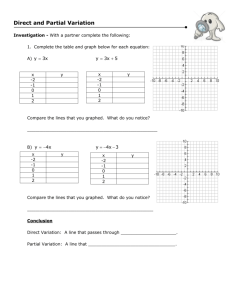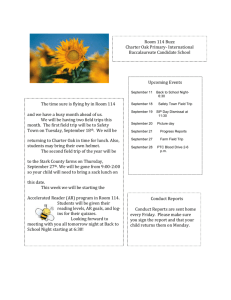
1
When embarking on a car road trip, it is smart to plan ahead.
A big road trip expense is gas to power your car. If you
don’t bring enough money, you could be stuck without
enough gas!
Luckily, knowing information about the distance you will
travel, the average price of gas, and the MPG (miles per
gallon) of your car, you can calculate how much money
you will need to pay for gas on your trip.
Your task will be to choose a car and a destination and make
a trip planner. You will need to do some calculations to
answer the following questions:
1.
1. How many gallons of gas will you need to reach your
destination?
2.
2. How much money will you spend on gas during
your trip?
3.
3. How many miles can your car travel on one tank?
4.
4. How many times will you need to stop for gas?
2
3
4
5
6
Next
Don’t let this happen to you!
Image Source: Parade Magazine,
http://www.parade.com/news/views/connie-schultz/100228-who-runs-out-of-gas.html
How can your knowledge of ratio relationships and unit rates help you to
plan the amount of gas and money you will need for a road trip?
1
2
3
4
5
Choose a car (year, make, and model) that you will drive on your road trip.
Find the car’s highway mpg.
US Department of Energy
MPG Buddy
Research the factors that affect mpg in a car. Choose a car that has a highway mpg of 35 or
greater. Identify features of the car that contribute to the high mpg.
Science Reference Center: Building the 100 MPG Car
BrainPop: Hybrid Cars
Top 10 Factors Contributing to Fuel Economy
NBC Learn: Congress Sets New Higher Standard for Auto Fuel Economy
Choose a destination (at least 100 miles away) and find the distance in miles
from your school to that location using the “Get Directions” function.
Google Maps
Mapquest
Baltimore Distance Calculator
Find the current national or regional average gas price per gallon.
AAA’s Daily Fuel Gauge Report
Gas Buddy
US Department of Energy
Image Source: Google Maps
Challenge
Extra Support
6
Next
1
2
3
4
5
6
Now that you have found the information about your car’s
mpg , the distance to your destination, and the average
price of gas, you will use this information to answer the
questions below.
- How many gallons of gas will you need to reach your
destination?
- How much money will you spend on gas during your trip?
- How many miles can your car travel on one tank?
- How many times will you need to stop for gas?
You will use your knowledge of ratio relationships and unit
prices to solve these problems.
Use this planning sheet to record your research and show
your calculations.
Image Source: Lindsay Hegadorn, All Clip Art from MS Word
Next
1
2
3
4
5
6
Next
Task 1: Make an Infographic
Use the information you have gathered from your research and your calculations
to create an infographic to show someone about to go on a road trip to your
chosen destination. An infographic is a way to explain your data using
pictures, graphics, and clipart. Click here for some examples.
To create your infographic, you may use a web 2.0 tool such as Glogster, Visual.ly,
or Easel.ly, 0r you can design your own using programs such as MS
Word, MS Power Point, Inspiration, or Pixie.
Your infographic does not need to look professional. You will be graded on how
well your images display the numbers you calculated. Here is the rubric that
will be used to assess your work.
Task 2: Write a Reflection
Reflect on the essential question posed on Slide 1:
How can your knowledge of ratio relationships and unit rates help you to plan the
amount of gas and money you will need for a road trip?
You may type your reflection in a Word document or respond to the prompt in
Edmodo.
Image Source: hotbutterstudio.com
1
There are several websites with trip planners
that calculate how much gas will cost you
on a road trip. Use the three following
online trip planners and input the same
information you used in your calculations.
Cost to Drive
AAA Fuel Cost Calculator
Gas Buddy
Which website’s estimate was closest to the
cost you calculated?
Image Source: Just2shutter
Freedigitalphotos.net
2
3
4
5
6
Next
Extra Opportunities to Explore
Websites/Interactives:
NCTM Challenge: How far can you go on tank of gas?
Shell: Energize Your Future: Educators: Calculating
Energy
Nurse Numbers: How a Nurse Uses Rate Formulas
Videos:
BrainPop: Cars
BrainPop: Gas and Oil
Safari Montage: Math'scool: Ratios, Rates, and
Proportional Reasoning
Games:
Unit Price and Comparison Game
Proportion and Ratio Jeopardy
Ratio Stadium
BP Gas Mania
1
2
3
4
5
6
Grade 5 GT Math
BCPS Curriculum / Maryland State Curriculum
Common Core State Standards
Understand ratio concepts and use ratio reasoning to solve problems.
6.RP.2 Understand the concept of a unit rate associated with a ratio a:b with b ≠ 0 (b not equal to zero), and
use rate language in the context of a ratio relationship. For example, "This recipe has a ratio of 3 cups
of flour to 4 cups of sugar, so there is 3/4 cup of flour for each cup of sugar." "We paid $75 for 15
hamburgers, which is a rate of $5 per hamburger." (Expectations for unit rates in this grade are limited
to non-complex fractions.)
6.RP.3 Use ratio and rate reasoning to solve real-world and mathematical problems, e.g., by reasoning
about tables of equivalent ratios, tape diagrams, double number line diagrams, or equations.
a. Make tables of equivalent ratios relating quantities with whole-number measurements, find missing
values in the tables, and plot the pairs of values on the coordinate plane. Use tables to compare ratios.
Standards for the 21st Century Learner
1.1.6 Read, view, and listen for information presented in any format (e.g. textual, visual, media, digital) in
order to make inferences and gather meaning.
2.1.3 Use strategies to draw conclusions from information and apply knowledge to curricular areas, realworld situations, and further investigations.
ISTE NETS - National Educational Technology Standards for Students
3. Research and Information Fluency: Students apply digital tools to gather, evaluate, and use information.
b. Locate, organize, analyze, evaluate, synthesize, and ethically use information from a variety of
sources and media.
4. Critical Thinking, Problem Solving, and Decision Making: Students use critical thinking skills to plan and
conduct research, manage projects, solve problems, and make informed decisions using appropriate
digital tools and resources. c. Collect and analyze data to identify solutions and/or make informed
decisions.
Time Frame: 2 – 3 60 minute class periods
The research and calculations should take one class period. The
assessment activities may take 1 or 2 periods.
Differentiation:
Direct students to use comprehension tools included in
databases, such as: audio read-aloud, labeled reading levels,
and embedded dictionaries.
Direct students who need more of a challenge to complete the
activities marked with a gold star.
Direct struggling students to use the silver star for
accommodations.
Learning Styles:
Field Dependent, Field Independent, Visual, Auditory,
Tactile, Active, Reflective, Global, Sequential
Notes to the teacher:
This activity can be done in the lab with the whole class completing it
at the same time. It can also be completed by several students at a
time using computers in the classroom.
Students should print out the planning sheet to do the calculations
and show their work with a pencil. You can collect this sheet
manually.
The infographic can be completed and submitted in an online
dropbox or uploaded onto a class wiki.
Assessment Task 2 gives the option to answer a question using
Edmodo. If you plan on giving your students this option, create a
group and post the essential question for students to respond to.
Last updated: December 2012
Created by Lindsay Hegadorn lhegadorn@bcps.org, Fifth Grade Teacher
BCPS Slam Dunk Research Model, Copyright 2012, Baltimore County Public Schools, MD, all rights reserved. The models may be used for educational, non-profit school use only.
All other uses, transmissions, and duplications are prohibited unless permission is granted expressly. This lesson is based on Jamie McKenzie’s Slam Dunk Lesson module.






